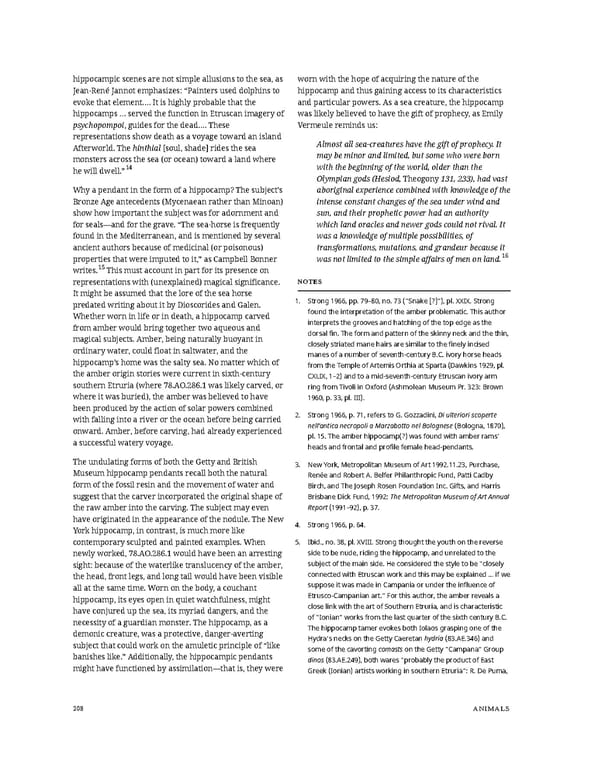hippocampic scenes are not simple allusions to the sea, as worn with the hope of acquiring the nature of the Jean-René Jannot emphasizes: “Painters used dolphins to hippocamp and thus gaining access to its characteristics evoke that element.… It is highly probable that the and particular powers. As a sea creature, the hippocamp hippocamps … served the function in Etruscan imagery of was likely believed to have the gift of prophecy, as Emily psychopompoi, guides for the dead.… These Vermeule reminds us: representations show death as a voyage toward an island Afterworld. The hinthial [soul, shade] rides the sea Almost all sea-creatures have the gift of prophecy. It monsters across the sea (or ocean) toward a land where may be minor and limited, but some who were born he will dwell.”14 with the beginning of the world, older than the Olympian gods (Hesiod, Theogony 131, 233), had vast Why a pendant in the form of a hippocamp? The subject’s aboriginal experience combined with knowledge of the Bronze Age antecedents (Mycenaean rather than Minoan) intense constant changes of the sea under wind and show how important the subject was for adornment and sun, and their prophetic power had an authority for seals—and for the grave. “The sea-horse is frequently which land oracles and newer gods could not rival. It found in the Mediterranean, and is mentioned by several was a knowledge of multiple possibilities, of ancient authors because of medicinal (or poisonous) transformations, mutations, and grandeur because it properties that were imputed to it,” as Campbell Bonner was not limited to the simple affairs of men on land.16 writes.15 This must account in part for its presence on representations with (unexplained) magical significance. NOTES It might be assumed that the lore of the sea horse predated writing about it by Dioscorides and Galen. 1. Strong 1966, pp. 79–80, no. 73 (“Snake [?]”), pl. XXIX. Strong Whether worn in life or in death, a hippocamp carved found the interpretation of the amber problematic. This author from amber would bring together two aqueous and interprets the grooves and hatching of the top edge as the magical subjects. Amber, being naturally buoyant in dorsal fin. The form and pattern of the skinny neck and the thin, ordinary water, could float in saltwater, and the closely striated mane hairs are similar to the finely incised hippocamp’s home was the salty sea. No matter which of manes of a number of seventh-century B.C. ivory horse heads from the Temple of Artemis Orthia at Sparta (Dawkins 1929, pl. the amber origin stories were current in sixth-century CXLIX, 1–2) and to a mid-seventh-century Etruscan ivory arm southern Etruria (where 78.AO.286.1 was likely carved, or ring from Tivoli in Oxford (Ashmolean Museum Pr. 323: Brown where it was buried), the amber was believed to have 1960, p. 33, pl. III). been produced by the action of solar powers combined 2. Strong 1966, p. 71, refers to G. Gozzadini, Di ulteriori scoperte with falling into a river or the ocean before being carried nell’antica necropoli a Marzabotto nel Bolognese (Bologna, 1870), onward. Amber, before carving, had already experienced pl. 15. The amber hippocamp(?) was found with amber rams’ a successful watery voyage. heads and frontal and profile female head-pendants. The undulating forms of both the Getty and British 3. New York, Metropolitan Museum of Art 1992.11.23, Purchase, Museum hippocamp pendants recall both the natural Renée and Robert A. Belfer Philanthropic Fund, Patti Cadby form of the fossil resin and the movement of water and Birch, and The Joseph Rosen Foundation Inc. Gifts, and Harris suggest that the carver incorporated the original shape of Brisbane Dick Fund, 1992: The Metropolitan Museum of Art Annual the raw amber into the carving. The subject may even Report (1991–92), p. 37. have originated in the appearance of the nodule. The New 4. Strong 1966, p. 64. York hippocamp, in contrast, is much more like contemporary sculpted and painted examples. When 5. Ibid., no. 38, pl. XVIII. Strong thought the youth on the reverse newly worked, 78.AO.286.1 would have been an arresting side to be nude, riding the hippocamp, and unrelated to the sight: because of the waterlike translucency of the amber, subject of the main side. He considered the style to be “closely the head, front legs, and long tail would have been visible connected with Etruscan work and this may be explained … if we all at the same time. Worn on the body, a couchant suppose it was made in Campania or under the influence of hippocamp, its eyes open in quiet watchfulness, might Etrusco-Campanian art.” For this author, the amber reveals a have conjured up the sea, its myriad dangers, and the close link with the art of Southern Etruria, and is characteristic necessity of a guardian monster. The hippocamp, as a of “Ionian” works from the last quarter of the sixth century B.C. demonic creature, was a protective, danger-averting The hippocamp tamer evokes both Iolaos grasping one of the subject that could work on the amuletic principle of “like Hydra’s necks on the Getty Caeretan hydria (83.AE.346) and banishes like.” Additionally, the hippocampic pendants some of the cavorting comasts on the Getty “Campana” Group dinos (83.AE.249), both wares “probably the product of East might have functioned by assimilation—that is, they were Greek (Ionian) artists working in southern Etruria”: R. De Puma, 208 ANIMALS
 Ancient Carved Ambers in the J. Paul Getty Museum Page 217 Page 219
Ancient Carved Ambers in the J. Paul Getty Museum Page 217 Page 219